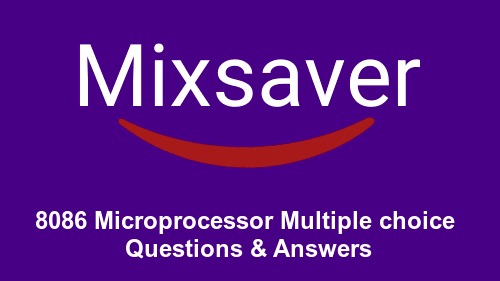1. The first micro-processor had a (n) ______.
a) 1-bit data bus
b) 2- bit data bus
c) 3-bit data bus
d) 4-bit data bus
Answer: d
2. __________ processor is first introduced by the Intel in 1971.
a) 8080
b) 4004
c) 8008
d) 8085
Answer: b
3. Which of the following is/are 8-bit microprocessor?
a) 8008
b) 8080
c) 8085
d) All of the mentioned
Answer: d
4. The limitations of the 8-bit microprocessors was/were is ________.
a) Low speed of execution
b) Low memory addressing capability
c) Less powerful instruction set
d) All of the mentioned
Answer: d
5. The number of addresses and data lines of 8085 are____.
a) 8 and 8
b) 16 and 8
c) 8 and 16
d) 16 and 16
Answer: b
6. Intel’s 8086 were launched in the year_____.
a) 1971
b) 1972
c) 1974
d) 1978
Answer: d
7. Which is the microprocessor comprises?
a) Register section
b) One or more ALU
c) Control unit
d) All of the mentioned
Answer: d
8. A 16-bits address bus can generate _____addresses.
a) 32767
b) 25652
c) 65536
d) None of the mentioned
Answer: c
9. The register of 8086 are_____ bits in size.
a) 8
b) 12
c) 16
d) 20
Answer: c
10. Which of the following registers are not available in 8086 microprocessor?
a) General data register
b) Segment registers
c) Pointer and Index register
d) All of the mentioned
Answer: d
11. Which of the following is a 16-bit register?
a) AL
b) AX
c) AH
d) All of the mentioned
Answer: b
12. _______ register is used as a default counter in case of string and loop instructions.
a) AX
b) BX
c) CX
d) DX
Answer: c
13. _____ register is used as an implicit operand or destination operand in case of arithmetic instructions and Input-Output instructions.
a) AX
b) BX
c) CX
d) DX
Answer: d
14. The number of address and data lines of 8086_________.
a) 8 and 8
b) 16 and 16
c) 20 and 16
d) 16 and 20
Answer: c
15. _______ is the most important segment and it contains the actual assembly language instructions to be executed by the microprocessor.
a) Data segment
b) Code segment
c) Stack segment
d) Extra segment
Answer: b
16. Base Pointer (BP) contains offset address of ________ segment.
a) Data segment
b) Code segment
c) Stack segment
d) Extra segment
Answer: a
17. Instruction Pointer (IP) contains offset address of ________ segment.
a) Data segment
b) Code segment
c) Stack segment
d) Extra segment
Answer: b
18. The Instruction Pointer is ______ bits in length.
a) 8 bits
b) 4 bits
c) 16 bits
d) 32 bits
Answer: c
19. The index register is used to hold __________.
a) Segment memory
b) Offset memory
c) Offset address
d) Segment address
Answer: c
20. SI and DI registers is used to store the offset addresses of _______.
a) CS and DS or ES
b) DS and DS or ES
c) DS or ES and CS
d) DS and ES
Answer: b
21. Which of the following is not a machine control flag?
a) Direction flag
b) Interrupt flag
c) Overflow flag
d) Trap flag
Answer: c
22. In 8086 the overflow flag is set when______.
a) The sum is more than 16 bit
b) Carry and sign flags are set
c) Signed numbers go out of their range after an arithmetic operation
d) During subtraction
Answer: c
23. Direction flag is used with ____.
a) String instructions
b) Stack Instructions
c) Arithmetic Instructions
d) Branch Instructions
Answer: a
24. If there is a carry from lowest nibble during addition, ______ flag sets.
a) Carry
b) Auxiliary carry
c) Over flow
d) Sign
Answer: b
25. If_________ flag is set; the processor enters the single step execution mode.
a) Direction
b) Trap
c) Interrupt
d) Zero
Answer: b
26. The Intel 8086 microprocessor is a_____ processor.
a) 8 bits
b) 4 bits
c) 16 bits
d) 32 bits
Answer: c
27. What is /are the improvement is in the architecture of 8086 over 8085 architecture
a) A 16-bit ALU, a set of 16-bit registers
b) Segmented memory addressing
c) Fetched instruction queue for overlapped fetching and execution
d) All of the mentioned
Answer: d
28. The BIU prefetches the instruction from memory and store them in _____.
a) Queue
b) Register
c) Memory
d) Stack
Answer: a
29. The 8086 fetch instruction one after another from ______ of memory.
a) Data segment
b) Code segment
c) Extra segment
d) Stack segment
Answer: b
30. Which is not part of execution unit?
a) ALU
b) Address conversion mechanism
c) Flag register
d) General purpose registers
Answer: b
31. The length of predecoding instruction byte queue is _______ bytes long.
a) 2
b) 4
c) 6
d) 8
Answer: c
32. If segment address = 1005 H, offset address = 5555 H, then the physical address is_____.
a) 655A H
b) 155A5 H
c) 4550 H
d) 56555
Answer: b
33. In a segment if offset is a 16-bit number, then the maximum possible locations are_____.
a) 1 KB
b) 64 bytes
c) 64 KB
d) 1 MB
Answer: c
34. If the size of the segment is 64 kb, what will be the starting and ending off set addresses of it
a) 0000H to 7FFFH
b) 0000H to FFFFH
c) 8000H to FFFFH
d) 00000H to FFFFFH
Answer: b
35. Of the segment addresses are assigned as 0000H to F000H and the offset addresses values are from 0000H to FFFFH, then the physical addresses range from_____.
a) 0000H to FFFFH
b) 00000H to F0000H
c) 00000H to FFFFF
d) 0000H to FFF0H
Answer: c





